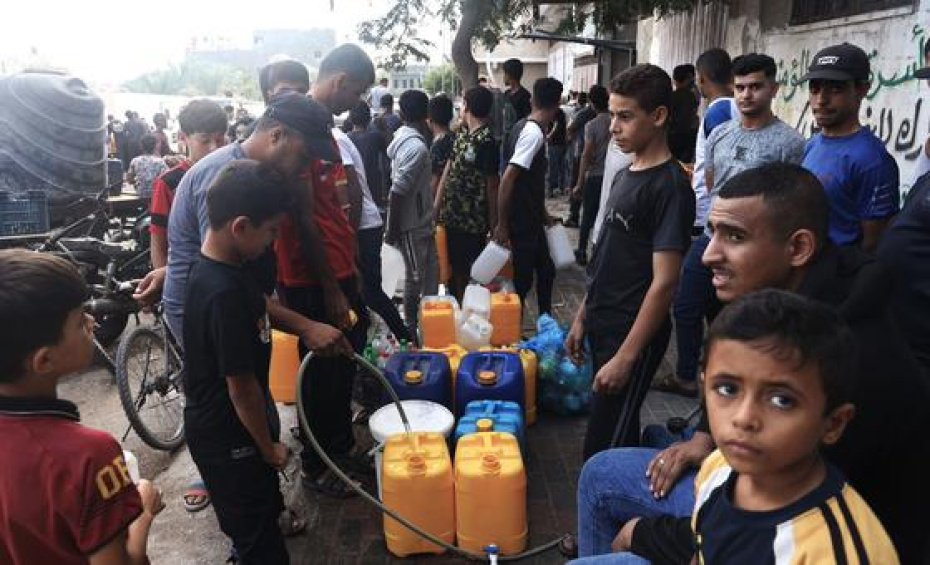Breadcrumb

Explainer: How aid reaches Gaza

The Rafah border crossing in Egypt has been called a lifeline into the besieged Gaza Strip, home to 2.3 million people, amid the escalating Israel-Palestine conflict. All other crossings were shuttered since hostilities began on 7 October. We took a look at how lifesaving aid travels into the enclave.
Barricaded for two weeks at the outset of the conflict, the Rafah crossing re-opened on 21 October following an Israel-Egyptian deal for limited entry of humanitarian aid deliveries. Still, only a trickle is getting across the border.
While media reports announce fresh efforts to get aid to Gaza, like French and Italian hospital ships and Jordan, Qatar and the United Arab Emirates’ airdrops of medical supplies, Rafah remains the only land entry point into the enclave to deliver lifesaving aid.
Here’s how aid gets to Gaza’s border:
‘We are ready to move’
As trapped Gazans face deteriorating humanitarian conditions, a growing number of countries, UN agencies and aid partners are sending planeloads of goods into the El Arish Airport in neighbouring Egypt, about 45 km (28 miles) from Rafah.
Operated by the World Food Programme (WFP), the UN Humanitarian Air Service (UNHAS) specializes in delivering aid in emergency situations. Over the past weeks, it has chartered multiple flights to carry tonnes and tonnes of emergency aid.
After authorities clear the cargo, the pallets of goods are loaded into border-bound trucks. The UN Office for the Coordination of Humanitarian Affairs (OCHA) has 460 trucks standing ready.
“We have the trucks, we have the plan, we have the people, we are in El Arish, we are ready to move,” Martin Griffiths, who heads OCHA, told reporters in Geneva on Wednesday, presenting a 10-point plan, including opening additional crossing points into Gaza from Israel to speed lifesaving aid deliveries.
He also welcomed a statement from the Israeli authorities “not to put a cap on the number of trucks going in".

Aid convoys
To date, Rafah remains the only land crossing to get aid into the enclave. At the outset of the humanitarian aid effort, Egypt supplied, among other things, more than 100 transport vehicles. Every day, a convoy of aid idles at the Rafah border, awaiting clearance to cross.
By 15 November, only 1,187 deliveries had entered Gaza since 21 October, according to the OCHA’s latest flash update. UN agencies are saying the vastly limited flow of aid is not enough.
Tuesday’s convoy of 91 trucks arrived in Gaza carrying precious cargo: food, medicines, health supplies, bottled water, blankets, tents and hygiene products.
Verification
At the Rafah border, Egyptian and Israeli authorities inspect the trucks.
All shipments are verified to ensure that vehicles contain only humanitarian goods before crossing into Gaza, explained Brian Lander, Deputy Head of Emergencies at the World Food Programme (WFP).
When cleared, each truck proceeds into Gaza.
Waiting there are staff from the Palestinian Red Crescent or the UN agency for Palestine refugees (UNRWA), which stand ready to operate aid distribution efforts.
Aid workers unload the newly arrived goods and then the trucks that delivered them return to Egypt.

Aid distribution
On the Gaza side, Palestinian Red Crescent or UNRWA staff then handle the transfer of pallets of humanitarian aid into delivery trucks, destined to drive to distribution sites or to depots, according to UN agencies.
“We work with the local authorities,” Mr. Lander said, emphasizing that WFP is guided by the principles of humanity, neutrality and impartiality. “We work with our partners that are on the ground to ensure that we’re providing that to vulnerable populations that are being affected by that conflict and are in need.”
However, distribution of supplies to shelters, clinics and other beneficiaries “has largely come to a halt due to lack of fuel”, according to OCHA, given Israel’s complete ban on fuel deliveries since the conflict began.

Fuel ban used as ‘weapon of war’
Even with the Israeli authorities’ decision on Wednesday to allow one fuel truck to enter Gaza, exclusively to fill the tanks of UN aid trucks in the enclave, OCHA said the 24,000 litres “represents a fraction of the fuel needs for humanitarian operations”.
“To cover the whole of the Gaza territory and therefore all of the people in need, we would need about 200,000 litres a day,” Mr. Griffiths said.
Meanwhile, Israel banned this first fuel delivery to Gaza in over a month from being distributed to other civilian locations, including hospitals.
“It can’t be used for the overall humanitarian response, including medical and water facilities,” UNRWA Commissioner General Philippe Lazzarini said in a social media post on Wednesday in response to Israel’s announcement. “It is appalling that fuel continues to be used as a weapon of war.”
Given the current alarming situation, Mr. Lazzarini appealed to all parties to stop using humanitarian assistance for political or military gains.
“It is very simple,” he said. “Without fuel, the humanitarian operation in Gaza is coming to an end. Many more people will suffer and will likely die.”
